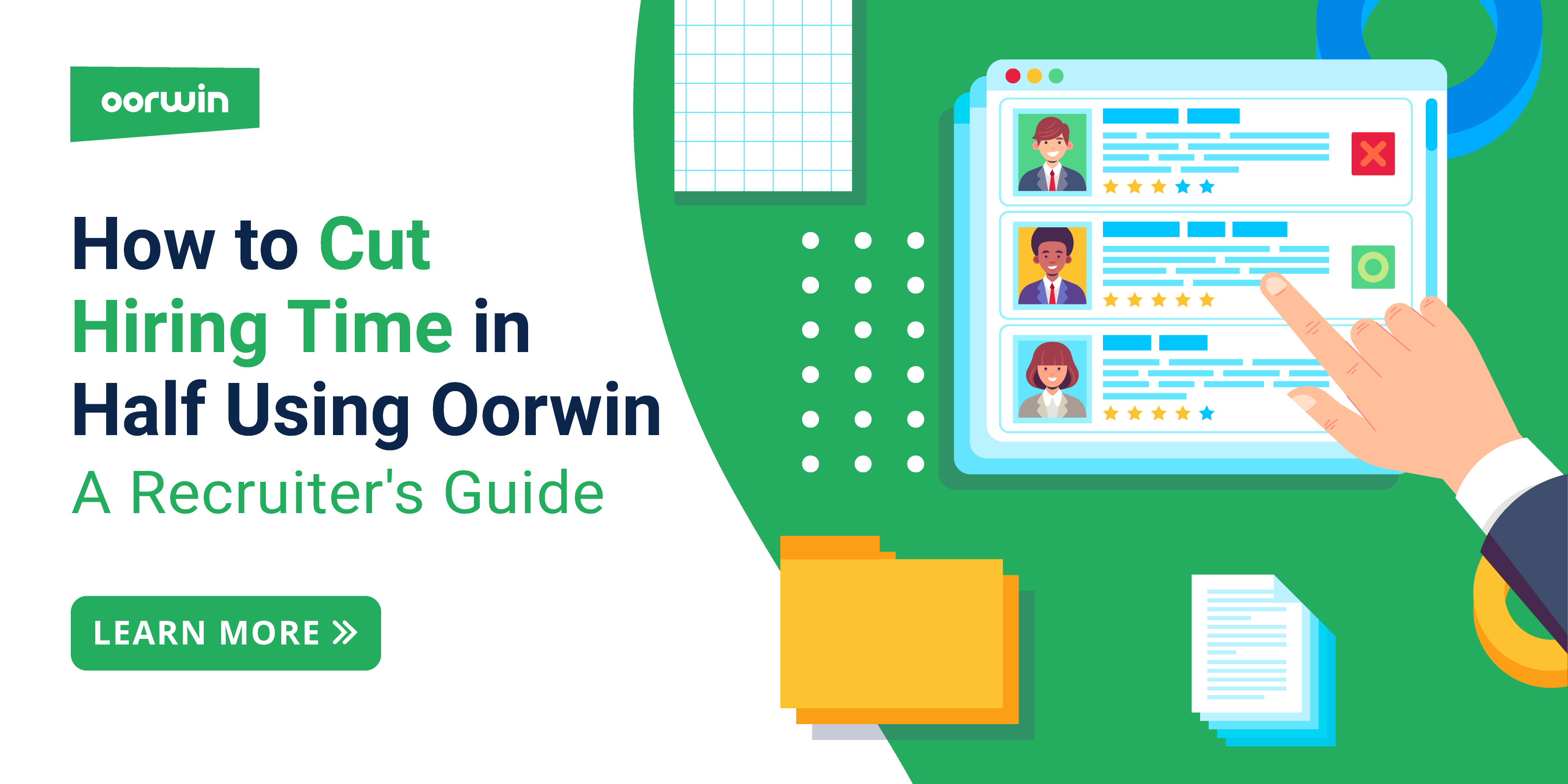Talent Acquisition: What It Is and How to Succeed
Oorwin
1min read / 29 Jun 2023

Related Articles
What is Talent Acquisition?
Talent acquisition is the process of identifying, attracting, and hiring the right individuals to meet the workforce needs of an organization. It involves a strategic approach to acquiring top talent, ensuring a competitive advantage in the market. Talent acquisition management focuses on long-term workforce planning and creating effective strategies to recruit and retain high-performing employees.
The Difference Between Talent Acquisition and Recruitment
While talent acquisition and recruitment are often used interchangeably, there is a subtle difference between the two. Recruitment refers to the process of filling specific job vacancies in an organization. It focuses on finding suitable candidates for immediate hiring needs. On the other hand, talent acquisition takes a broader perspective by proactively building a talent pipeline for future needs. It emphasizes long-term workforce planning and creating a pool of qualified candidates to meet the organization’s strategic goals.
The Talent Acquisition Process
The talent acquisition process involves several stages, each crucial in finding and attracting the right candidates for an organization.
Planning & Strategy Development
The first step is developing a comprehensive plan and strategy. This includes identifying the organization’s talent requirements, understanding the skills and competencies needed for each role, and aligning recruitment efforts with the overall business objectives. A well-defined strategy ensures that activities are targeted and effective.
Sourcing and Attracting Candidates
Once the strategy is in place, talent acquisition professionals focus on sourcing and attracting potential candidates. This involves utilizing various channels such as job boards, social media, networking events, and employee referrals to reach a diverse talent pool. Effective talent sourcing techniques ensure a wide range of qualified candidates are considered for open positions.
Screening and Selecting
After attracting candidates, the next step is to screen and select the most suitable individuals. This process typically involves reviewing resumes, conducting interviews, and assessing candidates’ skills and qualifications. Screening techniques may include behavioral, technical, and cultural fit assessments. The goal is to identify candidates who meet the job requirements and align with the organization’s values and culture.
Hiring and Onboarding
Once the best candidates have been selected, the talent acquisition process moves to the hiring and onboarding stage. This involves extending job offers, negotiating terms, and facilitating a smooth transition for new hires into the organization. Effective onboarding programs ensure new employees are welcomed, provided with necessary training and resources, and integrated into the company culture.
Key Principles for Successful Talent Acquisition
To excel in talent acquisition, organizations should consider the following key principles.
Utilizing Employer Branding
Employer branding plays a vital role in talent acquisition. It involves creating a positive perception of the organization as an employer of choice. By effectively showcasing the company’s values, culture, and opportunities for growth, employers can attract top talent and differentiate themselves from competitors.
Fostering a Positive Candidate Experience
Providing a positive candidate experience throughout the talent acquisition process is essential. This includes clear communication, timely feedback, and a seamless application process. A positive experience enhances the organization’s reputation and increases the likelihood of attracting and retaining top talent.
Leveraging Technology and Analytics
Technology and analytics have revolutionized talent acquisition in today’s digital age. Advanced applicant tracking systems, AI-powered recruitment tools, and data analytics help streamline processes, improve efficiency, and make data-driven decisions. These tools enable organizations to identify trends, optimize recruitment strategies, and enhance the talent acquisition process.
Emphasizing Diversity and Inclusion
Diversity and inclusion have become key priorities for talent acquisition. By actively seeking a diverse pool of candidates and fostering an inclusive work environment, organizations can unlock the benefits of diverse perspectives and experiences. Talent acquisition strategies aim to attract candidates from different backgrounds and ensure equal opportunities for all.
Optimizing Talent Acquisition with Technology
The use of technology has significantly transformed talent acquisition practices.
Evolution of Talent Acquisition Tools: Then and Now
Over time, talent acquisition tools have evolved from manual processes to sophisticated digital solutions. Traditional methods, such as newspaper advertisements and physical job fairs, have been replaced by online job portals, social media recruiting, and automated applicant tracking systems. These advancements have made talent acquisition more efficient, cost-effective, and accessible.
Leveraging Complete TA Suites for Enhanced Efficiency
Complete talent acquisition (TA) suites integrate various tools and functionalities into a single platform, providing end-to-end solutions for talent acquisition management. These suites often include applicant tracking, candidate relationship management, onboarding, and analytics capabilities. Organizations can streamline processes, improve collaboration, and gain valuable insights into their talent acquisition efforts by using complete TA suites.
The Benefits of a Centralized, Real-time TA Solution
Implementing a centralized, real-time talent acquisition solution offers several benefits. It provides a centralized database for candidate information, streamlines communication and collaboration among team members, and enables real-time tracking of recruitment metrics and analytics. Such solutions enhance efficiency, ensure consistent candidate experiences, and facilitate data-driven decision-making.
Translating Talent Acquisition Strategy into Action
Organizations need to consider key elements and collaborate with HR to execute talent acquisition strategies effectively.
The Essential Roles in a Talent Acquisition Team
A successful talent acquisition team comprises various roles and responsibilities. These may include talent acquisition managers, recruiters, sourcers, HR business partners, and hiring managers. Each role plays a crucial part in executing the talent acquisition strategy, from strategic planning and sourcing to interviewing and onboarding.
Collaborating with HR to Leverage Recruiting and Workforce Analytics
Collaboration between talent acquisition and HR teams is essential for effectively leveraging recruiting and workforce analytics. By aligning their efforts and sharing insights, these teams can optimize talent acquisition strategies, identify skill gaps, forecast future hiring needs, and enhance overall workforce planning.
Building a Candidate Evaluation Framework and Enhancing Employer Brand
Creating a candidate evaluation framework helps ensure a consistent and fair evaluation process. It involves defining key criteria, designing interview questions, and establishing assessment techniques tailored to specific roles. Additionally, organizations should continually enhance their employer brand through effective communication, employee testimonials, and positive candidate experiences.
Future Trends in Talent Acquisition
As talent acquisition continues to evolve, several emerging trends are shaping its future.
Rediscovering Talent: Revisiting Past Candidates
Organizations are increasingly recognizing the value of revisiting past candidates. With advancements in talent rediscovery technology, recruiters can identify and re-engage with candidates previously considered but not hired. This trend helps tap into a qualified talent pool and reduces time-to-hire.
The Rise of Hybrid Applicant Tracking-Candidate Relationship Management Solutions
Hybrid solutions that combine applicant tracking and candidate relationship management functionalities are gaining popularity. These integrated platforms allow recruiters to seamlessly manage both active applicants and passive candidates, nurturing relationships with potential talent while efficiently tracking and managing the hiring process.
Leveraging AI and Automation in Talent Acquisition
Artificial intelligence (AI) and automation are transforming talent acquisition practices. AI-powered tools can analyze resumes, screen candidates, conduct automated interviews, and provide valuable insights. Automation streamlines repetitive tasks, allowing recruiters to focus on strategic activities, improving efficiency, and enhancing the candidate experience.
Frequently Asked Questions
How does talent acquisition strategy differ across startups, retail chains, and enterprises?
Startups focus on entrepreneurial-minded individuals, retail chains prioritize customer service skills, and enterprises emphasize long-term planning and succession management in talent acquisition strategy.
How can technology optimize the talent acquisition process?
Technology automates tasks, streamlines communication, and provides data analysis, improving efficiency and decision-making in the talent acquisition process.
How can HR and talent acquisition teams collaborate to leverage recruiting and workforce analytics?
HR and talent acquisition teams collaborate by sharing data, insights, and expertise to align recruiting strategies with organizational goals and leverage analytics for workforce planning.
Ready to dive deeper? Explore these related resources:
Talent Acquisition: The Ultimate Guide
Talent Acquisition vs. Talent Management: Key Differences
5 Tips to Improve Your Talent Recruitment Practice and Hiring Strategy
Top 10 Talent Acquisition Software to Ace Your Hiring Game
Popular Articles..
Blog

9min read / 25-Jun-2025
Master Effective Interview Techniques with Oorwin: A Step-by-Step Recruiter’s Guide
Blog
Blog
Get the latest Oorwin releases, updates, success stories & industry news
 Back
Back
